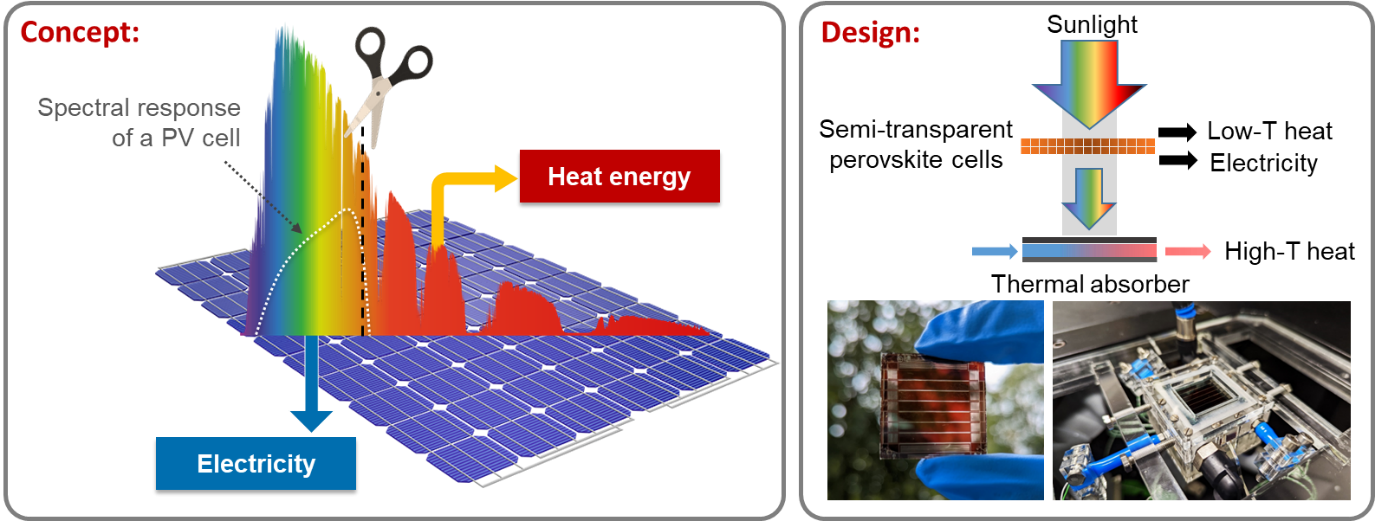Next-generation spectral-splitting hybrid solar photovoltaic-thermal technologies
- Type:Master Thesis
- Supervisor:
- Field of Study:
Mechanical/electrical/electronic engineering
- Links:Nanophotonics for Energy
Work's Description
Solar energy is one of the most abundant renewable energy sources, and effective solar technologies have a great potential to alleviate the grand challenges of satisfying rising energy demands, while reducing the associated emissions. Solar cells can convert solar energy directly into valuable electricity. The current commercial photovoltaic (PV) panels can convert 15-20% of the solar energy to electricity, while the rest is dissipated as waste heat in PV panels.
Spectral splitting hybrid solar photovoltaic-thermal (PVT) technology is capable of utilizing the full solar spectrum to simultaneously generate electricity and high-temperature thermal energy, potentially boosting the overall efficiency to 60-70%. It relies on the fact that a PV cell is only effective within a specific spectral range, e.g., 300-1100 nm for Si cells. As shown in the figure, spectral splitting design approaches spectrally separate the solar spectrum into different parts, only one of which is directed to the PV cell for electricity generation. The rest of the spectrum, which is not able to be electrically utilized by the cell, is sent to a separate solar thermal absorber for thermal energy generation, thus avoiding the unnecessary heating of the cell. Spectral-splitting PVT collectors typically employ additional selectively reflective (i.e., a dichroic mirror made of nanofilm layers) or selectively absorptive (i.e., nanofluids) optical filters to split the solar spectrum. However, both nanofluid and nanofilm optical filters are still facing challenges of significant optical loss, leading to a significant decrease (~50%) in PV efficiency. Overcoming the challenge requires transformative step-changes beyond the state-of-the-art.

This project will consider a novel spectrum management approach that is based on emerging semi-transparent perovskite solar cells, as shown in the figure. The semi-transparent solar cells selectively absorb a part of the solar spectrum for electricity generation, while the rest of the IR spectrum mostly can transmit through the PV cells. The transmitted IR spectrum is then absorbed by the solar thermal absorber, which can produce high-temperature heat without overheating the PV cells owing to the thermally-decoupled design, thereby overcoming the temperature limitations. Advanced energy materials will be fabricated and characterized in the project. The student will design, build, and test a proof-of-concept spectral-splitting PVT prototype in N4E lab. This project will also develop a comprehensive 3-D dynamic model that can be used for simulating and further optimizing the spectral-splitting PVT collectors. Potential applications of this novel PVT technology include high-efficiency hydrogen production, desalination, solar fuel generation, industrial heating etc., which could also be integrated into this project depending on the interests of the students.
Personal Qualifications
The student should have a strong interest in renewable energy. Some background in photovoltaic, heat transfer, mechanical engineering would be helpful. To complete the ambitious project within the limited time requires hard work, self-motivation, and cooperation with other colleagues in a multidisciplinary and international research group (N4E).
Contract's Duration: 6 Months Entry Date: On Appointment
click here for more information and online apply
Technical contact
Dr. Gan Huang
Karlsruhe Institute of Technology
Institute of Microstructure Technology
P.O. Box 3640
76021 Karlsruhe
phone: +49 721 608-22752
e-mail: gan.huang∂kit.edu

